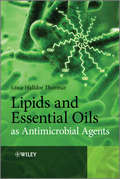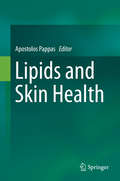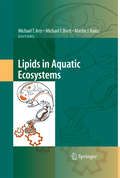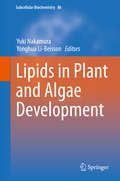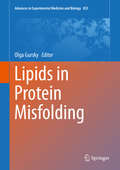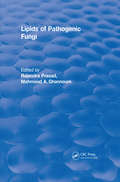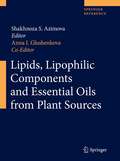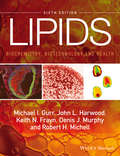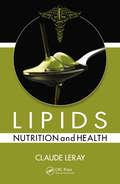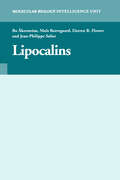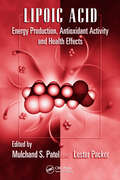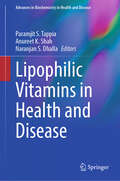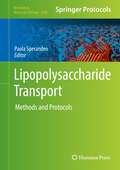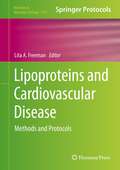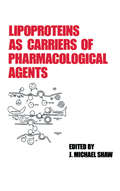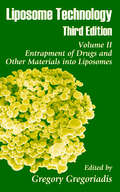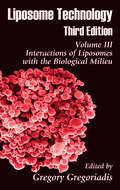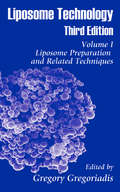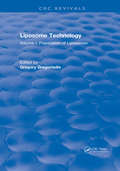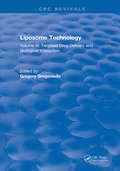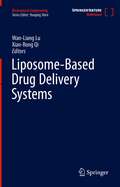- Table View
- List View
Lipids and Essential Oils as Antimicrobial Agents
by Halldor ThormarLipids and essential oils have strong antimicrobial properties -- they kill or inhibit the growth of microbes such as bacteria, fungi, or viruses. They are being studied for use in the prevention and treatment of infections, as potential disinfectants, and for their preservative and antimicrobial properties when formulated as pharmaceuticals, in food products, and in cosmetics.Lipids and Essential Oils as Antimicrobial Agents is a comprehensive review of the scientific knowledge in this field. International experts provide summaries on:the chemical and biological properties of lipids and essential oilsuse of lipids and essential oils in pharmaceuticals, cosmetics and health foodsantimicrobial effects of lipidsin vivo and in vitroantimicrobial lipids in milkantimicrobial lipids of the skinantibacterial lipids as sanitizers and disinfectantsantibacterial, antifungal, and antiviral activities of essential oilsantimicrobial lipids in milkantimicrobial lipids of the skinantibacterial lipids as sanitizers and disinfectantsantibacterial, antifungal, and antiviral activities of essential oilsLipids and Essential Oils as Antimicrobial Agents is an essential guide to this important topic for researchers and advanced students in academia and research working in pharmaceutical, cosmetic and food sciences, biochemistry and natural products chemistry, microbiology; and for health care scientists and professionals working in the fields of public health and infectious diseases. It will also be of interest to anyone concerned about health issues and particularly to those who are conscious of the benefits of health food and natural products.
Lipids and Skin Health
by Apostolos PappasLipids and Skin Health is the first effort to summarize and review the studies, ideas, and research that link lipid metabolism to the largest organ of our body, the skin. The book covers the fundamental biology of the skin, and the major involvement of the transcriptional factors that govern lipid synthesis and the bioactive lipids in this intriguing organ. All layers of skin are presented, as well as their relevant lipids from the epidermis to dermis and even to the hypodermis. The important and unique-to-skin biological pathways are laid out, with a special focus on the various models that demonstrate the essential role of lipid synthesis in skin pathophysiology. The use of lipids in the cosmetic industry is emphasized, and last but not least the involvement of lipids in the clinical setting is also discussed. This book will appeal to healthcare professionals, researchers and dermatology professionals, and will help them to brainstorm new products and opportunities that will target the emerging importance of lipid metabolism in skin for acne, aging, and healthy skin. Apostolos Pappas, Ph. D. , is a professional member of the Institute of Food Technology. He started his professional career as a research biochemist in the Skin Research Center of Johnson & Johnson and later served as a group leader at Munich Biotech, where he worked on cancer research. Thereafter he returned to Johnson & Johnson, where he is currently a Research Manager and Fellow focusing on lipid metabolism research. He has authored numerous scientific publications, patent applications, and books.
Lipids in Aquatic Ecosystems
by Martin Kainz Michael T. Arts Michael T. BrettEvidence now suggests that the roles of essential fatty acids as growth promoters and as indices of health and nutrition are fundamentally similar in freshwater and marine ecosystems. Lipids in Aquatic Ecosystems integrates this divergent literature into a coordinated, digestible form. Chapters are organized so as to discuss and synthesize the flow of lipids from lower to higher trophic levels, up to and including humans. Linkages between the production, distribution and pathways of these essential compounds within the various levels of the aquatic food webs, and their ultimate uptake by humans and other terrestrial organisms, are highlighted throughout the book. This book will be of interest to researchers and resource managers working with aquatic ecosystems.
Lipids in Photosynthesis
by Hajime Wada Norio MurataLipids in Photosynthesis: Essential and Regulatory Functions, provides an essential summary of an exciting decade of research on relationships between lipids and photosynthesis. The book brings together extensively cross-referenced and peer-reviewed chapters by prominent researchers. The topics covered include the structure, molecular organization and biosynthesis of fatty acids, glycerolipids and nonglycerolipids in plants, algae, lichens, mosses, and cyanobacteria, as well as in chloroplasts and mitochondria. Several chapters deal with the manipulation of the extent of unsaturation of fatty acids and the effects of such manipulation on photosynthesis and responses to various forms of stress. The final chapters focus on lipid trafficking, signaling and advanced analytical techniques. Ten years ago, Siegenthaler and Murata edited "Lipids in Photosynthesis: Structure, Function and Genetics," which became a classic in the field. "Lipids in Photosynthesis: Essential and Regulatory Functions," belongs, with its predecessor, in every plant and microbiological researcher's bookcase.
Lipids in Plant and Algae Development
by Yuki Nakamura Yonghua Li-BeissonThis book summarizes recent advances in understanding the functions of plant and algal lipids in photosynthesis, in development and signaling, and in industrial applications. As readers will discover, biochemistry, enzymology and analytical chemistry, as well as gene knock-out studies have all contributed to our rapidly increasing understanding of the functions of lipids. In the past few decades, distinct physical and biochemical properties of specific lipid classes were revealed in plant and algal lipids and the functional aspects of lipids in modulating critical biological processes have been uncovered. These chapters from international authors across relevant research fields highlight the underlying evolutionary context of lipid function in photosynthetic unicellular and multicellular organisms. The book goes on to encompass what lipids can do for industrial applications at a time of fascination with plants and algae in carbon fixation and as sources for production of food, energy and novel chemicals. The developmental context is a part of the fresh and engaging perspective that is presented in this work which graduate students and scientists will find both illuminating and useful.
Lipids in Protein Misfolding
by Olga GurskyProtein conversion from a water-soluble native conformation to the insoluble aggregates and fibrils, which can deposit in amyloid plaques, underlies more than 20 human diseases, representing a major public health problem and a scientific challenge. Such a conversion is called protein misfolding. Protein misfolding can also involve errors in the topology of the folded proteins and their assembly in lipid membranes. Lipids are found in nearly all amyloid deposits in vivo, and can critically influence protein misfolding in vitro and in vivo in many different ways. This book focuses on recent advances in our understanding of the role of lipids in modulating the misfolding of various proteins. The main emphasis is on the basic biophysical studies that address molecular basis of protein misfolding and amyloid formation, and the role of lipids in this complex process.
Lipids of Pathogenic Fungi (CRC Press Revivals)
by Rajendra Prasad Mahmoud A. GhannoumIncreases in various fungal infections due to Candida, Aspergillus, Blastomyces, Histoplasma spp., and Dermatophytes have attracted interest in the biochemistry of the fungal pathogens responsible. This book discusses the importance of lipids in pathogenic fungi and how they are involved in infections that pose serious health problems. The role of lipids in dimorphism, adherence, and virulence of fungi is investigated as is their composition and metabolism. Several chapters are devoted to examinations of specific pathogenic fungi, which will be particularly useful to researchers studying the clinical manifestations of infections caused by these factors. Later chapters present possible antifungal agents and nonconventional agents that target the organisms discussed earlier. Collectively, the contributions to this volume provide an excellent overview of this field. This text is essential for practicing clinicians and for everyone involved in the important task of resolving the problems associated with fungal pathogenicity.
Lipids, Lipophilic Components and Essential Oils from Plant Sources
by Shakhnoza S. Azimova Valentina I. Vinogradova Anna I. GlushenkovaA comprehensive collection covering more than 3,000 plants Offers systematic information on the lipids and natural oils that can be extracted from each part of the plant Includes material not previously readily available in English
Lipids: Biochemistry, Biotechnology and Health
by Professor Denis J. Murphy Professor John L. Harwood Professor Keith N. Frayn Dr Michael I. Gurr Professor Robert H. MichellFor the 6th Edition of this highly regarded textbook devoted to lipids, the title has been modified from Lipid Biochemistry to Lipids to acknowledge the coming together of biological and medical sciences, the increasingly blurred boundaries between them and the growing importance of lipids in diverse aspects of science and technology. The principal aims of this new edition - to inform students and researchers about lipids, to assist teachers and encourage further research - have not changed since previous editions. Significant advances in lipid science have demanded yet another extensive rewriting for this edition, with the addition of two new authors, to cover new knowledge of genes coding for proteins involved in lipid metabolism, the many lipids involved in cell signalling, the roles of lipids in health and disease and new developments in biotechnology in support of agriculture and industry.An introductory chapter summarizes the types of lipids covered and their identification and provides a guide to the contents. Chapters contain boxes illustrating special topics, key point summaries and suggested further reading.Lipids: 6th Edition provides a huge wealth of information for upper-level students of biological and clinical sciences, food science and nutrition, and for professionals working in academic and industrial research. Libraries in all universities and research establishments where biological, medical and food and nutritional sciences are studied and taught should have copies of this excellent and comprehensive new edition on their shelves.
Lipids: Nutrition and Health
by Claude LerayThe role of lipids in nutrition science has evolved considerably in the past decade with new concepts following new discoveries. Lipids: Nutrition and Health reviews the role of dietary lipids in maintaining health, bringing the latest knowledge from a myriad of sources into one convenient resource. Taking a combined approach that integrates lipid
Lipocalins
by Bo Akerstrom Niels Borregaard Darren R. Flower Jean-Philippe SalierLess than a decade has elapsed since the publication in 2000 of the first anthology devoted to lipocalins (Biochim Biophys Acta 1482, 2000), and only a few years since the first Lipocalin International Symposium in Copenhagen in 2003 (Benzon Symposium no. 50The Lipocalin Protein Superfamily, Copenhagen, 2003) and the introduction of a public lip
Lipoic Acid: Energy Production, Antioxidant Activity and Health Effects
by Mulchand S. Patel Lester PackerThe recognition of oxidative stress as a major factor in health, aging, and disease has led to a surge in research aimed at uncovering effective countermeasures in the form of antioxidants. Unique in its two-fold protective function, alpha-lipoic acid has drawn unprecedented interest as a coenzyme in mitochondrial energy metabolism and as an antiox
Lipophilic Vitamins in Health and Disease (Advances in Biochemistry in Health and Disease #28)
by Naranjan S. Dhalla Paramjit S. Tappia Anureet K. ShahThe concept of “vital amines” as essential nutrients was introduced over a century ago by Dr Casimir Funk. It was suggested that there is a family of organic substances that are required in minute amounts and essential for life. The increase in incorporation of vitamins and supplementation in routine dietary practices is expected to increase. In fact, it has been estimated that 60% of worldwide consumers are taking vitamin supplements on a daily basis, a trend that will most likely rise across the world.This book brings together international experts in the field of vitamins for human health and disease, to update and integrate current understanding on the effects of different lipophilic vitamins on cellular, metabolic and molecular biochemical reactions with respect to different pathophysiological conditions including cardiovascular disease, cancer, metabolic defects, inflammatory and immune diseases. This book is uniquely positioned as it focuses on the biochemistry and molecular biology of lipophilic vitamins in diverse cell systems in relation to human health and disease.The book will certainly stimulate and motivate biomedical researchers and scientists to further explore the relationship between lipophilic vitamins and biological processes, as well as serve as a highly useful resource for nutritional investigators, health professionals, medical students, fellows, residents and graduate students. We hope that the reader will gain knowledge and further understanding of the importance of lipophilic vitamins. The novel insights provided by the contributing authors will assist in advancing preventive medicine worldwide as well as bring forward knowledge that may help in the use of lipophilic vitamins as adjuvant to therapeutic strategies for human disease.
Lipopolysaccharide Transport: Methods and Protocols (Methods in Molecular Biology #2548)
by Paola SperandeoThis volume provides the most widely used protocols and techniques employed in lipopolysaccharide( LPS) transport studies. Chapters detail identification and analysis of essential genes and crucial mutations in LPS transport-related genes, LPS profile determination, LPS chemical analysis, protein-LPS interaction, and LPS visualization. Written in the format of the highly successful Methods in Molecular Biology series, each chapter includes an introduction to the topic, lists necessary materials and reagents, includes tips on troubleshooting and known pitfalls, and step-by-step, readily reproducible protocols. Authoritative and cutting-edge, Lipopolysaccharide Transport: Methods and Protocols aims to deliver an overview on the multidisciplinary study of LPS transport and to identify new and innovative antibacterial strategies.
Lipoprotein Protocols
by Jose M. OrdovasJose Ordovas compiles a cutting-edge collection of molecular protein techniques for studying advanced aspects of lipoprotein structure and metabolism. These step-by-step methods allow both the beginning and the advanced researcher to carry out not only fundamental, but also the most advanced genetic screening techniques, including RT-PCR and the preparation of relevant models of transgenic and knockout mice. In addition, novel techniques are presented to characterize plasma lipoproteins, their subfractions, and their modifications, and to determine the activity of relevant enzymes and carrier proteins. Each method is described in easily reproducible detail by a hands-on expert who has perfected it. Lipoprotein Protocols offers many powerful tools for unraveling the complexity of lipoprotein metabolism and determining the individual risk of coronary heart disease.
Lipoproteins and Cardiovascular Disease: Methods and Protocols
by Lita A. FreemanThe lipid-rich and otherwise challenging nature of many key tissues complicates many aspects of current research, and applications of the unique nature of lipoproteins and their biological effects has engendered unique and vital methodologies. In Lipoproteins and Cardiovascular Disease: Methods and Protocols, experts in the field present a compendium of advanced and classical molecular biology methods targeted towards lipoprotein, atherosclerosis, and vascular biology research, bringing together in a single volume an updated set of protocols and strategies for methods now driving the most recent advances, along with classical methods that are still widely used. Among the many topics covered in this cutting-edge work, the book delves into crucial techniques such as quantitative real-time PCR, microarrays, RT-PCR laser capture microdissection, and tissue-specific gene overexpression, knockout, and knockdown methodologies, including AAV as a liver-directed gene delivery vehicle. Written in the highly successful Methods in Molecular BiologyTM series format, chapters include introductions to their respective subjects, lists of the necessary materials and reagents, step-by-step, readily reproducible laboratory protocols, and valuable notes which highlight tips on troubleshooting and avoiding known pitfalls. Comprehensive and easy to use, Lipoproteins and Cardiovascular Disease: Methods and Protocols serves both novices and experts alike as a complete guide for any researcher with an interest in lipoproteins and their significant biological effects.
Lipoproteins as Carriers of Pharmacological Agents
by J. Michael ShawExplores endogenous lipoprotein particles and their interaction with pharmacological agents. Among the topics are receptor-dependent interactions of lipoproteins with tissues and cell types, their uptake and transport with the vascular endothelium, therapeutic and chemical agents that associate in v
Lipoproteins in Diabetes Mellitus
by Peter P. Toth Alicia J. Jenkins Timothy J. LyonsDiabetes mellitus has become epidemic on a global scale, and millions of new cases are diagnosed every year. The epidemic of diabetes mellitus is expected to result in one of the steepest rises in human morbidity and mortality ever observed outside of wartime. Insulin resistance is a hallmark of pre-diabetes and type 2 diabetes mellitus, and is characterized by impaired insulin-signaling transduction. Authoritative and comprehensive, Lipoproteins in Diabetes Mellitusdetails the many changes wrought by insulin resistance and diabetes mellitus on lipid and lipoprotein metabolism. The book begins by summarizing the various techniques to measure lipoproteins and their subclasses. The mechanisms by which insulin resistance and diabetes mellitus increase risk for atherosclerosis, diabetic retinopathy, and diabetic nephropathy are then explored in detail. Finally, the effects of lifestyle modification and the results of clinical trials using established and investigational drugs are discussed. An invaluable contribution to the literature, Lipoproteins in Diabetes Mellitusis a comprehensive reference on the clinical and scientific aspects of lipoproteins in diabetes. It will have a long-lasting and significant effect on the medical management of people with diabetes.
Liposome Drug Delivery Systems
by Guru V. Betageri Scott Allen Jenkins Daniel ParsonsGuide to current liposome drug delivery technology. Applications, preparation, pharmacokinetics, stability, passive and active targeting, and industrial production. Special emphasis on "stealth" liposomes (liposomes with extended circulation times).
Liposome Technology: Entrapment of Drugs and Other Materials into Liposomes
by Gregory GregoriadisLiposome Technology, Volume II: Entrapment of Drugs and Other Materials into Liposomes, Third Edition is a comprehensively updated and expanded new edition of a classic text in the field. Including step-by-step technical details, Volume II describes procedures for the incorporation of drugs and other materials into liposomes for a variety therapeut
Liposome Technology: Interactions of Liposomes with the Biological Milieu
by Gregory GregoriadisLiposome Technology, Volume III: Interactions of Liposomes with the Biological Milieu, Third Edition, is a comprehensively updated and expanded new edition of a classic text in the field. Including step-by-step technical details, Volume III describes technologies for yielding liposomes that can function in a targeted fashion, and highlights methods
Liposome Technology: Liposome Preparation and Related Techniques
by Gregory GregoriadisLiposome Technology, Volume I: Liposome Preparation and Related Techniques, Third Edition, is a thoroughly updated and expanded new edition of a classic text in the field. Including step-by-step technical details, Volume I illustrates numerous methods for liposome preparation and auxiliary techniques necessary for the stabilization and characteriza
Liposome Technology: Volume I
by GregoriadisAlthough the role of liposomes in drug targeting has been discussed extensively in several reviews and books, there has been no comprehensive coverage of related methodology. This book constitutes the first attempt to put together all aspects of lipsome technology as applied to medical sciences. Volume I deals directly with methods for the preparation of liposomes and auxiliary techniques.
Liposome Technology: Volume III: Targeted Drug Delivery and Biological Interaction
by GregoriadisAlthough the role of liposomes in drug targeting has been discussed extensively in several reviews and books, there has been no comprehensive coverage of related methodology. This book constitutes the first attempt to put together all aspects of lipsome technology as applied to medical sciences. Volume III is devoted to the growing variety of techniques yielding targeted liposomes and to approaches of studying liposomal behaviour in the biological milieu both in vitro and in vivo.
Liposome-Based Drug Delivery Systems (Biomaterial Engineering)
by Wan-Liang Lu Xian-Rong QiThis volume describes the protocols for fabrication of liposomal drug delivery system, and consists of two parts. The first part emphasizes the basic protocols and concepts for fabrication of drug-loaded liposomes. For new investigators, laying the groundwork is the first step. This part focuses on the fabrication details in liposomes formulations, which are the so-called small tricks while usually not disclosed in mostly published research articles. However, these processing details are crucial for the preparation of liposomes. And the second part focuses on the strategies in modified and/or functionalized liposomes to adapt to pathophysiological environment, as well as their application in treating diseases. As new analytical and synthetic technologies become available, and improved understanding of pathophysiology, various functionalized drug liposomes are developing to fit the requirements of different therapeutic purposes, exhibiting a broad range of applications. Accordingly, the objectives of this part are aimed at deeply unearthing the formulation of drug-loaded liposomes, describing the detailed operation of liposomal formulation, and further demonstrating their potential applications. Therefore, this volume shows the features of experimental report or protocol for proving a guide to scientists, research students, and young investigators in pharmaceutical enterprises.
